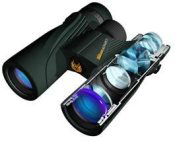
|
A bright view can make all the difference in the performance of binoculars: A brighter image provides more detail in the image you are viewing. More specifically, it’s easier to see details of birds in the field or at your feeding station. Take a look at the objective lens in a series of binoculars – a simple eyeball view of the larger end of the binoculars will tell you which models will provide brighter images.
Objective lenses are the two larger lenses positioned at the end of a binocular. The diameter of each objective lens, measured in millimeters, is the second number in the binocular’s numeric description – for example, an 8x42 binocular has an objective lens that measures 42mm across. Larger objective lenses produce a brighter image than small objective lenses if the magnification is the same. A 50mm objective lens is extra large, while a 30mm objective lens is close to the other extreme in size. Compact binoculars have very small objective lenses compared to full-sized binos – hence, the image you see is going to be less bright.
The level of brightness is especially important when studying birds in low light conditions. A binocular that provides a brighter image, such as when conditions provide only dim ambient light or when a bird is perched in the shadows, is obviously preferred. The added brightness provided by a large objective lens really pays off in the low-light conditions at dawn or dusk, and during cloudy or poor-weather days. A large objective lens can even gather more light than unaided human eyes, making your birding experiences better and brighter.